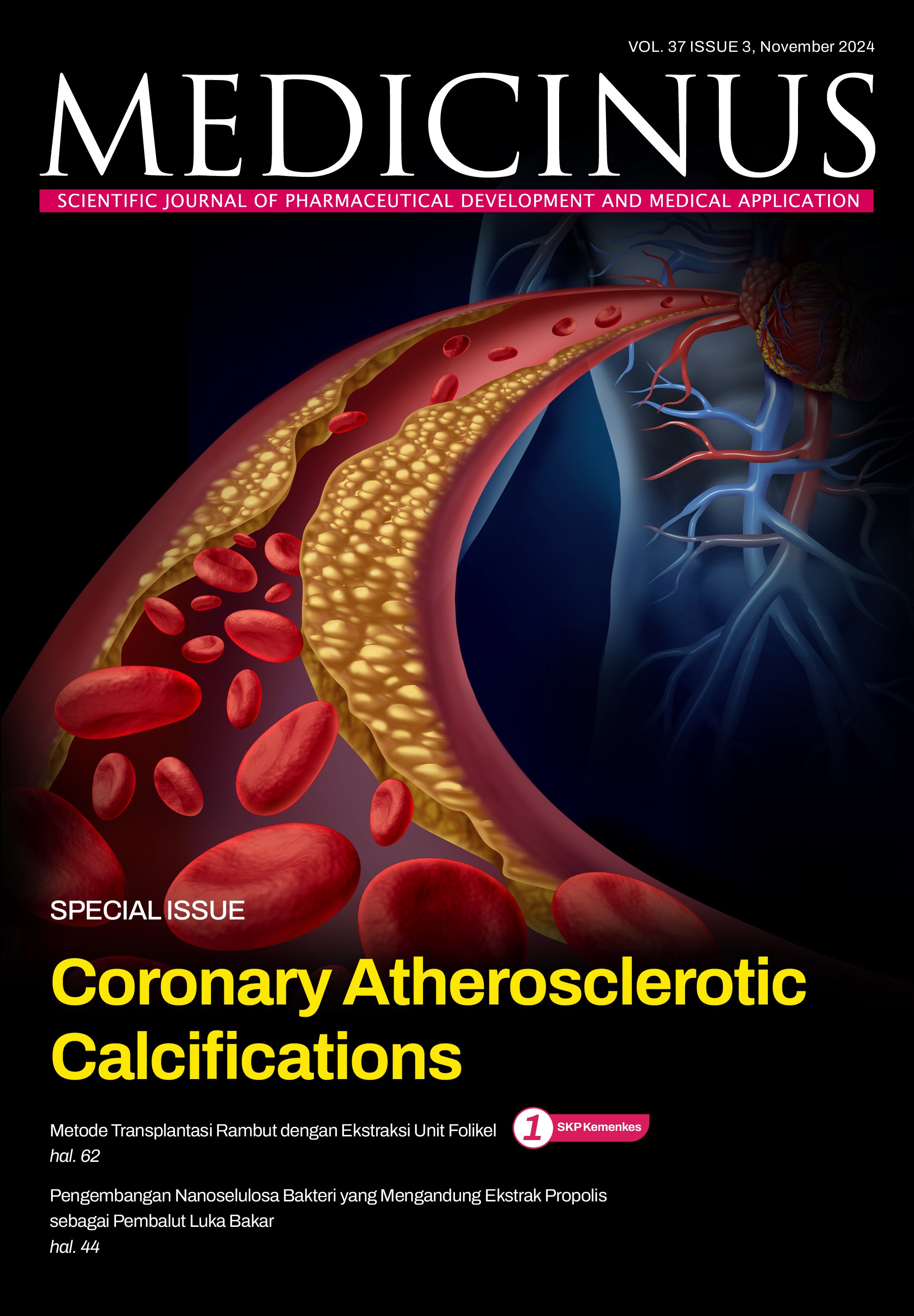Terapi Terkini Pityriasis Rosea
DOI:
https://doi.org/10.56951/72h6tw89Kata Kunci:
pityriasis rosea, terapi terkiniAbstrak
Pityriasis rosea (PR) merupakan erupsi kulit papuloskuamosa akut. Penyebab PR belum diketahui secara pasti, namun diduga akibat gangguan imunitas seluler atau infeksi HHV-6 dan HHV-7. Umumnya kondisi ini bersifat self-limiting disease dan akan mengalami pemulihan spontan dalam waktu beberapa minggu hingga bulan dengan pengobatan simtomatik topikal maupun sistemik. Penyakit ini relatif jarang mengalami kekambuhan. Dari keseluruhan kasus PR, terdapat beberapa kasus yang memerlukan terapi tambahan, seperti pada kasus lesi yang luas, pruritus berat, dan pasien yang dalam masa kehamilan. Tata laksana PR terbagi ke dalam tiga lini. Tata laksana lini pertama terdiri dari pemberian corticosteroid topikal, emolien, dan antihistamin oral. Lini kedua yaitu fototerapi narrow-band ultraviolet B (NBUVB) dan fototerapi ultraviolet A1 (UVA1). Kemudian lini ketiga terdiri dari terapi prednisone oral, erythromycin, acyclovir, dan dapsone.
Unduhan
Referensi
Clark M, Gudjonsson JE. Pityriasis rosea. In: Kang S, Amagai M, Bruckner AL, Enk AH, Margolis DJ, McMichael AJ, et al., editor. Fitzpatrick’s Dermatology. 9th edition. New York: McGraw-Hill; pp. 518–24.
Drago F, Broccolo F, Rebora A. Pityriasis rosea: an update with a critical appraisal of its possible herpesviral etiology. J Am Acad Dermatol. 2009;61(2):303–18. DOI: https://doi.org/10.1016/j.jaad.2008.07.045
Data Kunjungan Poliklinik Kulit dan Kelamin, Unit Rawat Jalan Terpadu RSUPN dr. Cipto Mangunkusumo. 2018.
Neoh CY, Tan AWH, Mohamed K, Sun YJ, Tan SH. Characterization of the inflammatory cell infiltrate in herald patches and fully developed eruptions of pityriasis rosea. Clin Exp Dermatol. 2010;35(3):300–4. DOI: https://doi.org/10.1111/j.1365-2230.2009.03469.x
Villalon-Gomez JM. Pityriasis rosea: diagnosis and treatment. Am Fam Physician. 2018;97(1):38-44.
Watanabe T, Kawamura T, Aquilino EA, Blauvelt A, Jacob SE, Orenstein JM, et al. Pityriasis rosea is associated with systemic active infection with both human herpesvirus-7 and human herpesvirus-6. J Invest Dermatol. 2002;119(4):793–7. DOI: https://doi.org/10.1046/j.1523-1747.2002.00200.x
Drago F, Ciccarese G, Broccolo F, Ghio M, Contini P, Thanasi H, et al. The role of cytokines, chemokines, and growth factors in the pathogenesis of pityriasis rosea. Mediators Inflamm. 2015;2015:1–6. DOI: https://doi.org/10.1155/2015/438963
Mahajan K, Relhan V, Relhan AK, Garg VK. Pityriasis rosea: an update on etiopathogenesis and management of difficult aspects. Indian J Dermatol. 2016;61(4):375–84. DOI: https://doi.org/10.4103/0019-5154.185699
Roxo R, Miranda C, Souza T, Gonzaga C, Azevedo L, Miranda M. Lysine for pityriasis rosea: is it a new treatment option? J Am Acad Dermatol. 2018;79(3):184. DOI: https://doi.org/10.1016/j.jaad.2018.05.748
Anna E M. Pityriasis rosea. In: Lebwohl MG, Heyman WR, Beth-Jones J, Colson I, editor. Treatment of Skin Disease: Comprehensive Therapeutic Strategies. 5th edition. Amsterdam: Elsevier; 2018; pp.2132-9.
Kwatra SG, Loss M. Other topical medications. In: Kang S, Amagai M, Bruckner AL, Enk AH, Margolis DJ, McMichael AJ, Orringer JS, editor. Fitzpatrick’s Dermatology. 9th edition. New York: McGraw-Hill; 2019. pp. 3610–22.
Mak MF, Li W, Mahadev A. Calamine lotion to reduce skin irritation in children with cast immobilisation. J Orthop Surg. 2013;21(2):221–5. DOI: https://doi.org/10.1177/230949901302100222
Sethi A, Kaur T, Malhotra S, Gambhir M. Moisturizers: The slippery road. Indian J Dermatol. 2016;61(3):279. DOI: https://doi.org/10.4103/0019-5154.182427
Schwartz RA. Pityriasis rosea [Internet]. Medscape. 2021 [cited 20 September 2021]. Available at: https://emedicine.medscape.com/article/1107532-overview.
Drago F, Vecchio F, Rebora A. Use of high-dose acyclovir in pityriasis rosea. J Am Acad Dermatol. 2006;54(1):82–5. DOI: https://doi.org/10.1016/j.jaad.2005.06.042
Katzung BG, editor. Antiviral Agents. In: Katzung BG, Masters SB, Trevor AJ, editor. Basic & Clinical Pharmacology. 14th edition. New York: McGraw-Hill; 2018. pp. 863–94.
Widaty S, Soebono H, Nilasari H, Listiawan MY, Siswati A, Triwahyudi D, et al., editor. Panduan Praktik Klinis. Jakarta: PERDOSKI; 2017. pp. 34–5
Dinos GP. The macrolide antibiotic renaissance: the present and future of macrolide antibiotics. Br J Pharmacol. 2017;174(18):2967–83. DOI: https://doi.org/10.1111/bph.13936
Sharma P, Yadav T, Gautam R, Taneja N, Satyanarayana L. Erythromycin in pityriasis rosea: a double-blind, placebo-controlled clinical trial. J Am Acad Dermatol. 2000;42(2):241– 4. DOI: https://doi.org/10.1016/S0190-9622(00)90132-4
Rasi A, Tajziehchi L, Savabi-Nasab S. Oral erythromycin is ineffective in the treatment of pityriasis rosea. J Drugs Dermatol. 2008;7(1):35–8.
Ahmed N, Iftikhar N, Bashir U, Rizvi SDA, Sheikh ZI, Manzur A. Efficacy of clarithromycin in pityriasis rosea. J Coll Physicians Surg Pak. 2014;24:5.
Ehsani A, Esmaily N, Noormohammadpour P, Toosi S, Hosseinpour A, Hosseini M, et al. The comparison between the efficacy of high dose acyclovir and erythromycin on the period and signs of pityriasis rosea. Indian Journal of Dermatology. 2010;55(3):246–8. DOI: https://doi.org/10.4103/0019-5154.70672
Acharya A, Murty MS. Effect of macrolide on pityriasis rosea in comparison with acyclovir. J of Evolution of Med and Dent Sci. 2015;4(27):4689–94. DOI: https://doi.org/10.14260/jemds/2015/678
Al-Timimi G, Al-Mashhadani S, Al-Waiz M. Doxycycline in pityriasis rosea: placebo- controlled clinical trial. J Fac Med Baghdad. 2007;49(1):5. DOI: https://doi.org/10.32007/jfacmedbagdad.4911434
Anderson CR. Dapsone treatment in a case of vesicular pityriasis rosea. The Lancet 1971;298(7722):493. DOI: https://doi.org/10.1016/S0140-6736(71)92662-6
Sonthalia S, Kumar A, Zawar V, Priya A, Yadav P, Srivastava S, et al. Double-blind randomized placebocontrolled trial to evaluate the efficacy and safety of short-course low-dose oral prednisolone in pityriasis rosea. J Dermatolog Treat. 2018;29(6):617–22. DOI: https://doi.org/10.1080/09546634.2018.1430302
Jairath V, Mohan M, Jindal N, Gogna P, Monnappa P, Kaur S, et al. Narrowband UVB phototherapy in pityriasis rosea. Indian Dermatol Online J. 2015;6(5):326. DOI: https://doi.org/10.4103/2229-5178.164480
Castanedo-Cazares JP, Lepe V, Moncada B. Should we still use phototherapy for pityriasis rosea? Photodermatol Photoimmunol Photomed. 2003;19(3):160–1. DOI: https://doi.org/10.1034/j.1600-0781.2003.00029.x
York NR, Jacobe HT. UVA1 phototherapy: a review of mechanism and therapeutic application: UVA1 phototherapy. Int J Dermatol. 2010;49(6):623–30. DOI: https://doi.org/10.1111/j.1365-4632.2009.04427.x
Lim SH, Kim SM, Oh BH, Ko JH, Lee YW, Choe YB, et al. Low-dose ultraviolet A1 phototherapy for treating pityriasis rosea. Ann Dermatol. 2009;21(3):230. DOI: https://doi.org/10.5021/ad.2009.21.3.230
Ebert M, Otsuka M. Treatment of pityriasis rosea by the injection of thyphoid vaccine. JAMA 1943;123(16):1036–7. DOI: https://doi.org/10.1001/jama.1943.82840510002007a
Contreras-Ruiz J, Peternel S, Jiménez Gutiérrez C, Culav-Koscak I, Reveiz L, Silbermann- Reynoso M de L. Interventions for pityriasis rosea. [Internet]. Cochrane Database of Systematic Reviews. 2019 [cited 20 September 2021]. Available at:https://doi.wiley.com/10.1002/14651858.CD005068.pub3 DOI: https://doi.org/10.1002/14651858.CD005068.pub3
Pedrazini MC, Groppo FC. L-lysine therapy to control the clinical evolution of pityriasis rosea: clinical case report and literature review. Dermatologic Ther. 2021;34(1):1-6. DOI: https://doi.org/10.1111/dth.14679
Unduhan
Terbitan
Bagian
Diterbitkan
Unduhan
Lisensi
Hak Cipta (c) 2024 Riyanti Astrid Diahtantri, Aida SD Hoemardani, Yudo Irawan

Artikel ini berlisensi Creative Commons Attribution-NonCommercial 4.0 International License.




